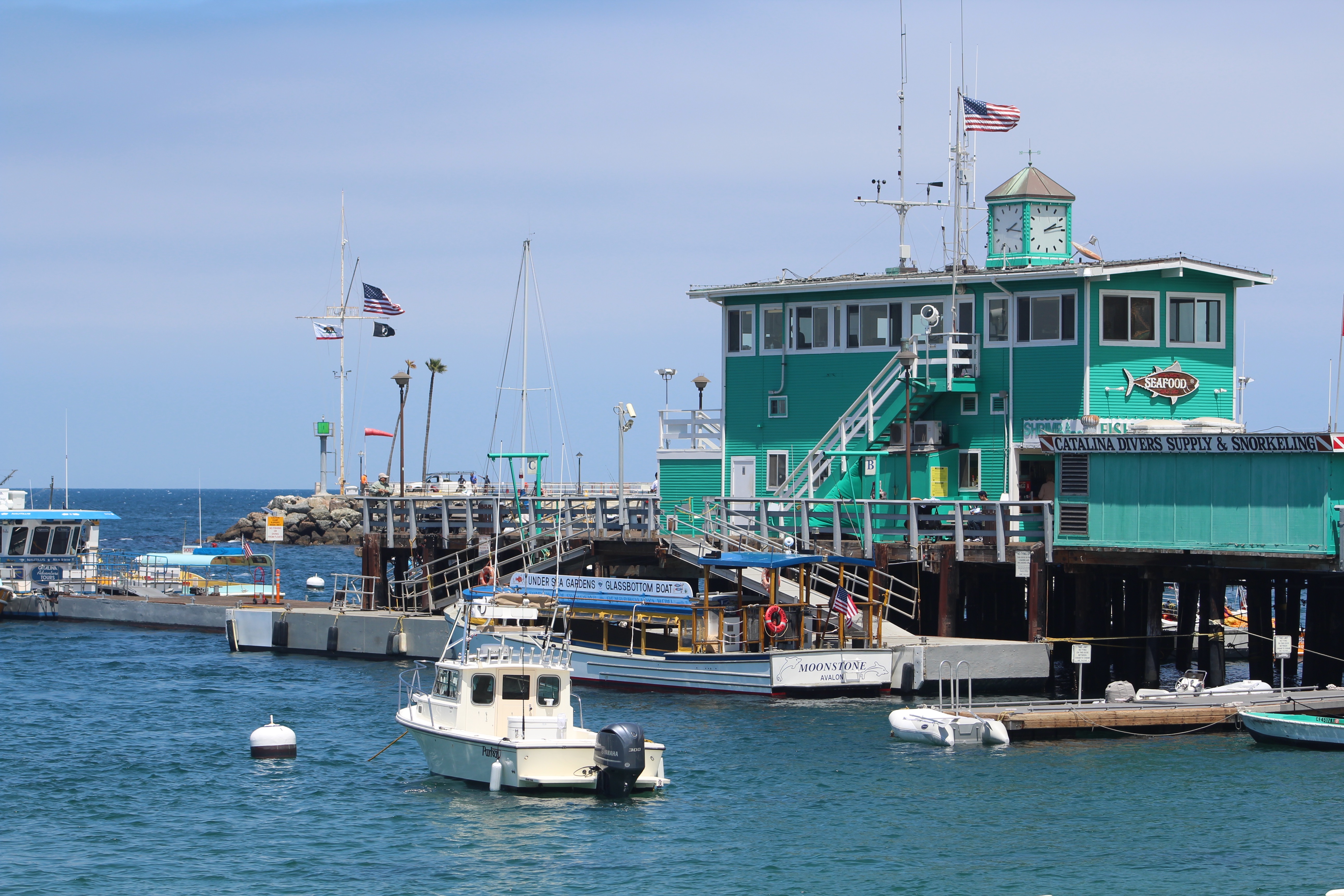
During the winter, when the outer dock is moved, and some of the tourist boats are moved, more space is available. From Easter Week well into the fall, space is at a premium. At most about a half dozen anglers can fit in at the end section and even then you have to be very careful to avoid tangling your line.
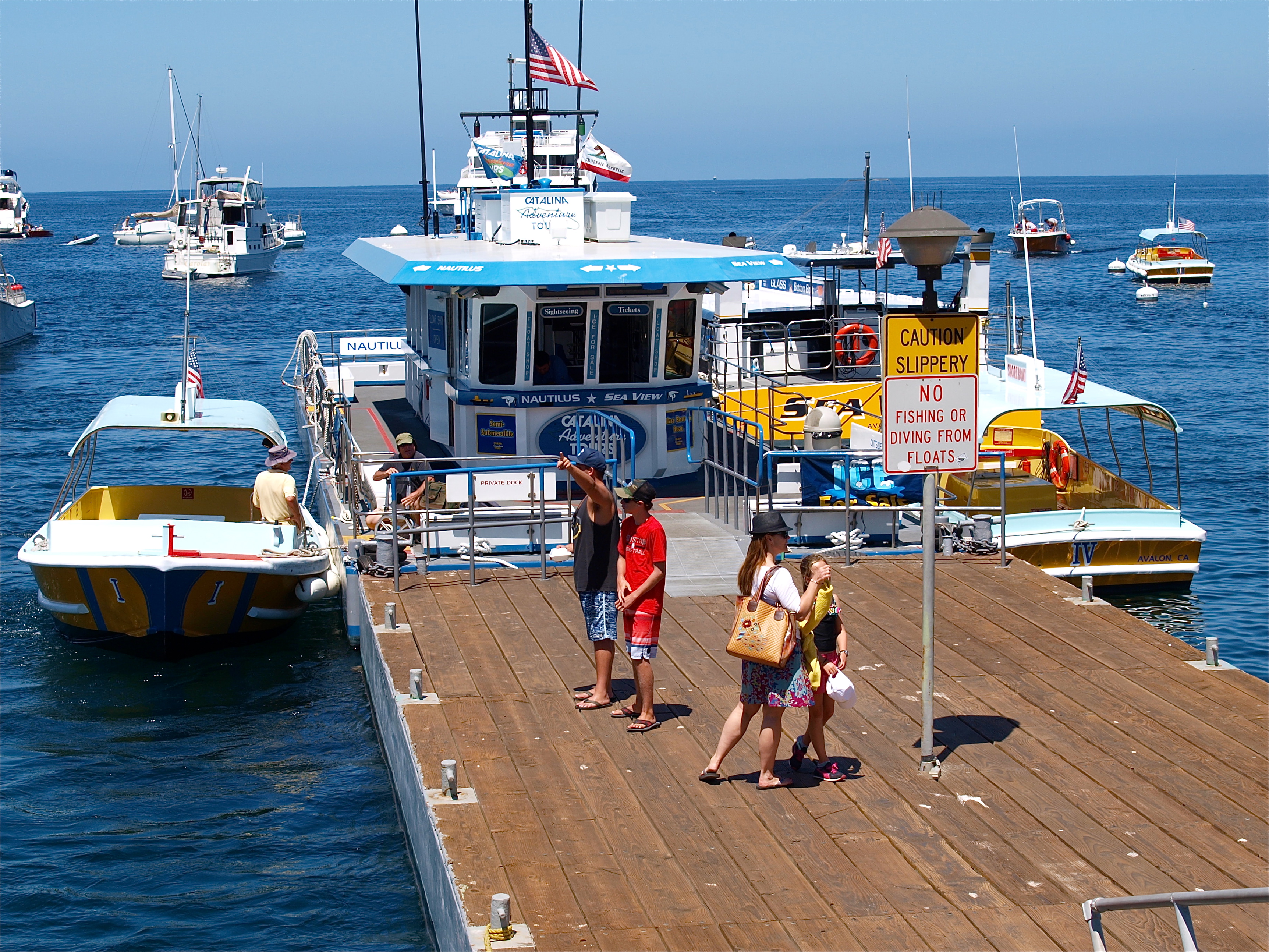
A dock is added to the front of the pier each summer season.
Catalina, the Magic Isle, and Avalon, have been destination spots since the late 1800s and it’s more popular than ever. Avalon itself only has about 4,000 year-round residents but the Chamber of Commerce has done its job well. The result is that over a million people a year crowd Avalon’s streets and the small town can be crowded most days from spring until the fall, especially during weekends. Restaurants can be crowded, stores can be crowded, the sidewalks are crowded, the bay is crowded (with yachts), and the pier is crowded.
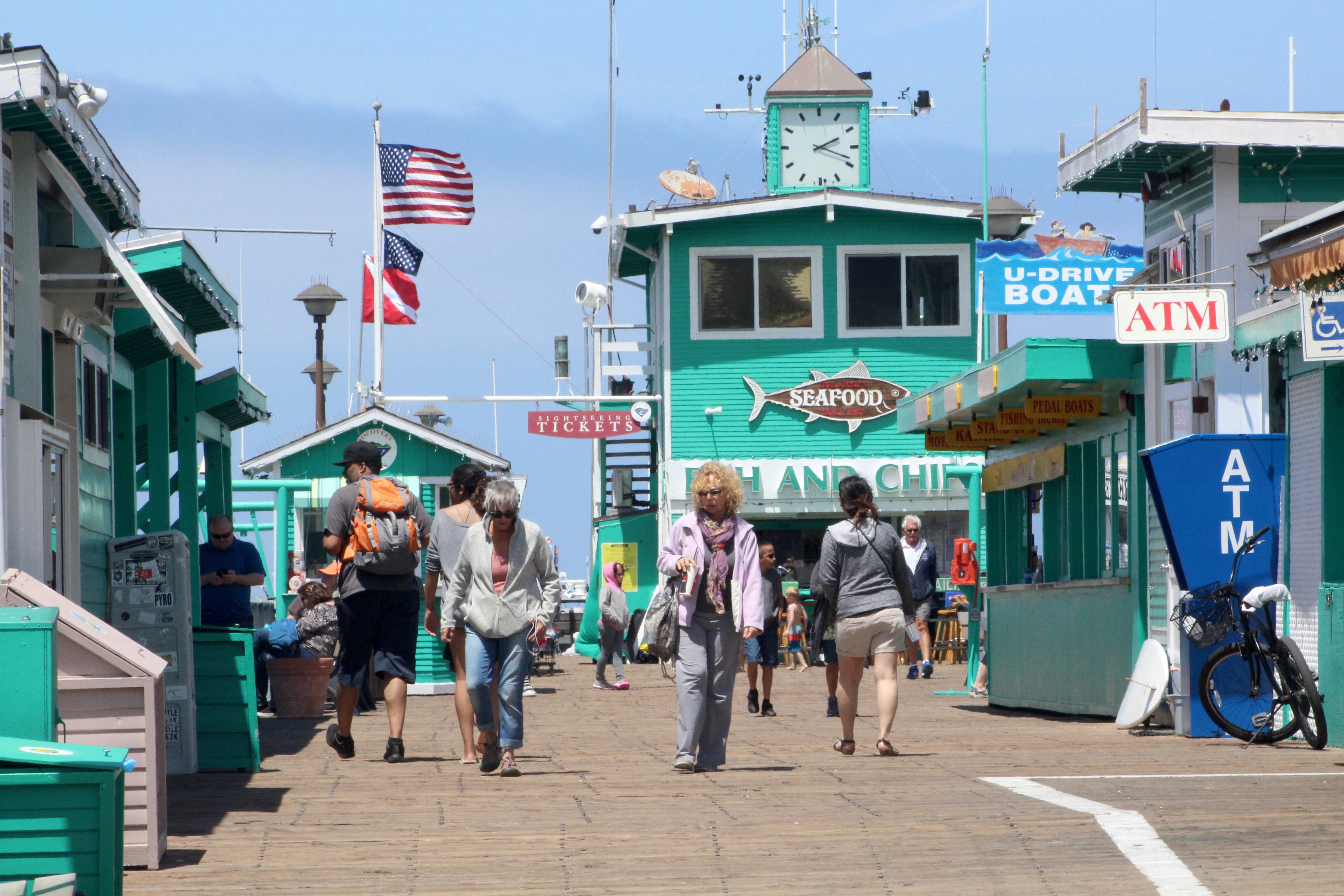
And, given all those fish that are seen in the waters at the end of the pier, a lot of people rent tackle and head out to the end of the pier to catch some fish. It can, at times, be too crowded. Sometimes it’s better to simply leave the pier to the crowds (mostly youngsters) and head out to the Mole. Such is progress. Come back at night and you may have the pier to yourself.
Fish — This pier, as well as the nearby Cabrillo Mole, was the setting for the first “Pier Fishing in California Pier Rat Get Together.” It took place in April of 2002 and attracted an eminent group of dedicated, enthusiastic and intelligent pier anglers from the web site (pierfishing.com). Coming from a plethora of California cities stretching from San Francisco to San Diego, people had a chance to fish together, socialize and put the faces to the names they had seen on the PFIC Message Board.
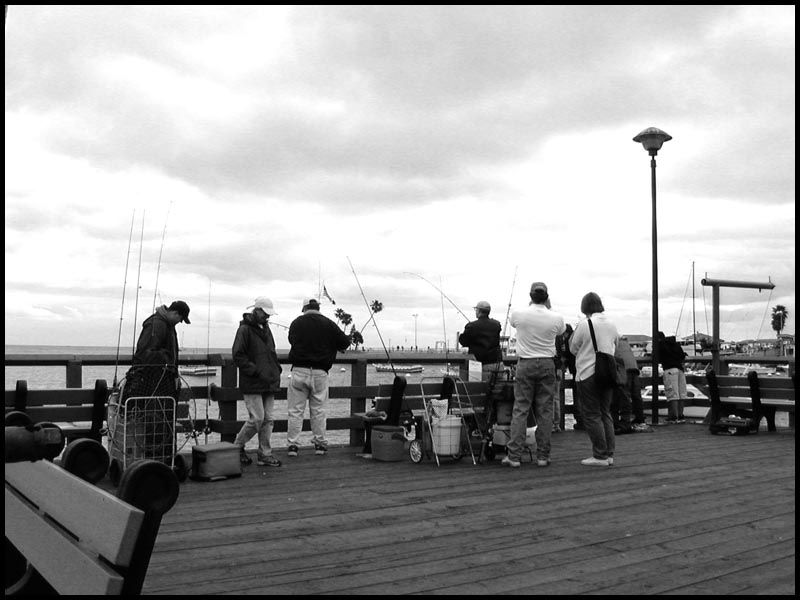
It was one of the most enjoyable experiencing of my pier-fishing career and led me to designate Avalon as my personal Brigadoon (or perhaps El Dorado), and to give the nod to this small pier as my favorite pier. The gemutlich (warm and congenial) fellowship shared by the pier rats during the limited time we had together provided frabjous (better than fabulous) memories that will last a lifetime.

The Get-Togethers continued and even expanded as United Pier and Shore Anglers of California became a joint sponsor. People came from as far away as Louisiana, and the group’s size continually grew until the 2010s when a combination of Catalina price increases and a slow economy saw a dip in attendance; the decrease led to 2015 being the last gathering.
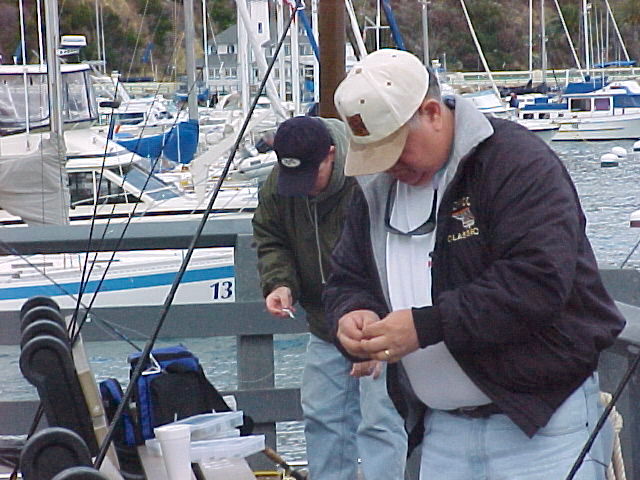
A prayerful moment!
What I saw at the gatherings encouraged me to make even more visits to Catalina and the visits, at various times of the year, have provided some statistics for the Green Pleasure Pier (GPP) that are pretty interesting.
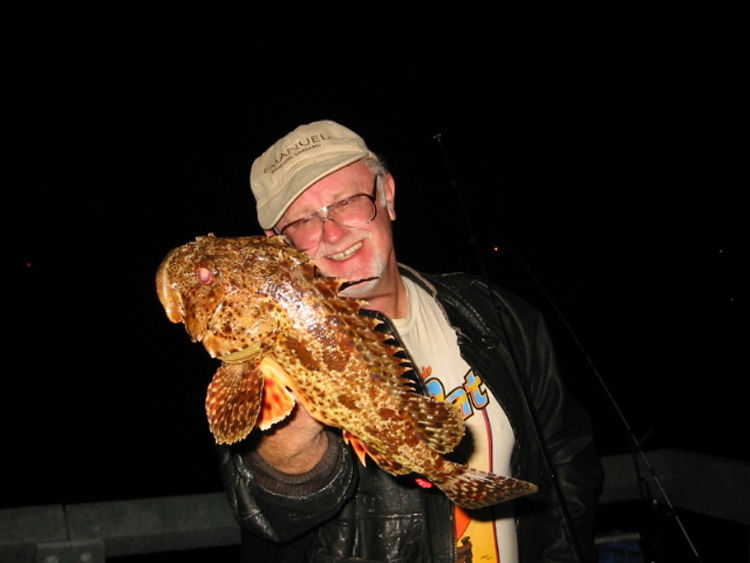
Pierhead (Boyd Grant) with a scorpionfish
The stats: through 2017, I’ve made 54 trips to the pier and caught neatly three thousand fish. The fish per hour average is 12.8 and the points per hour average (that incorporates both number and and quality of fish) is 26.7. Both are the highest averages for any pier in the state.
Included in the statistics are a decent variety—21 different species (not counting lobsters, spider (sheep) crabs and octopus that were caught). The fish, in the order they were caught: kelp bass, halfmoon, rock wrasse, senorita, shinerperch, opaleye, Pacific mackerel, sheephead, jack mackerel, blacksmith, California scorpionfish, Pacific sardine, garibaldi, jacksmelt, ocean whitefish, island surfperch, black seaperch, salema, northern anchovy, sand bass and largemouth blenny.
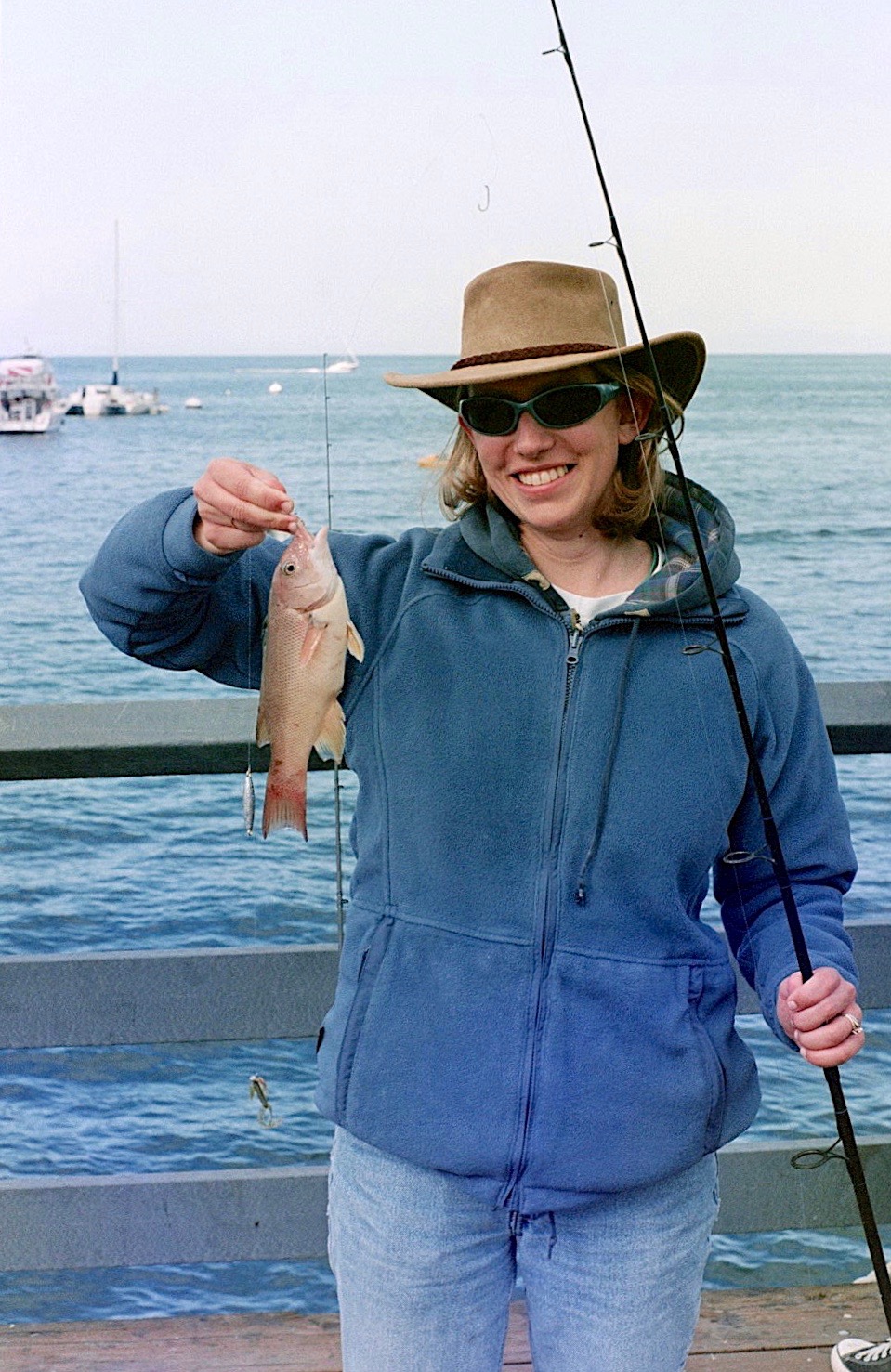
Roosterqueen (Rebecca) with a small sheephead
Seen caught by others, or lost, were several additional species including California halibut, Pacific bonito, horn sharks, swell sharks, moray eels, and bat rays. The numbers of fish are somewhat amazing but it’s because most of the fish are fairly small and they are fairly easy to catch if you know what you are doing. And even those with little clue will normally be able to pull in at least a few fish.
Small, generally illegal-size kelp bass (calico bass) are almost inevitably the number one catch on the pier as far as numbers. Unfortunately you will catch 20 undersized fish to every one that approaches or exceeds the 14-inch minimum size (although larger bait yields larger fish).
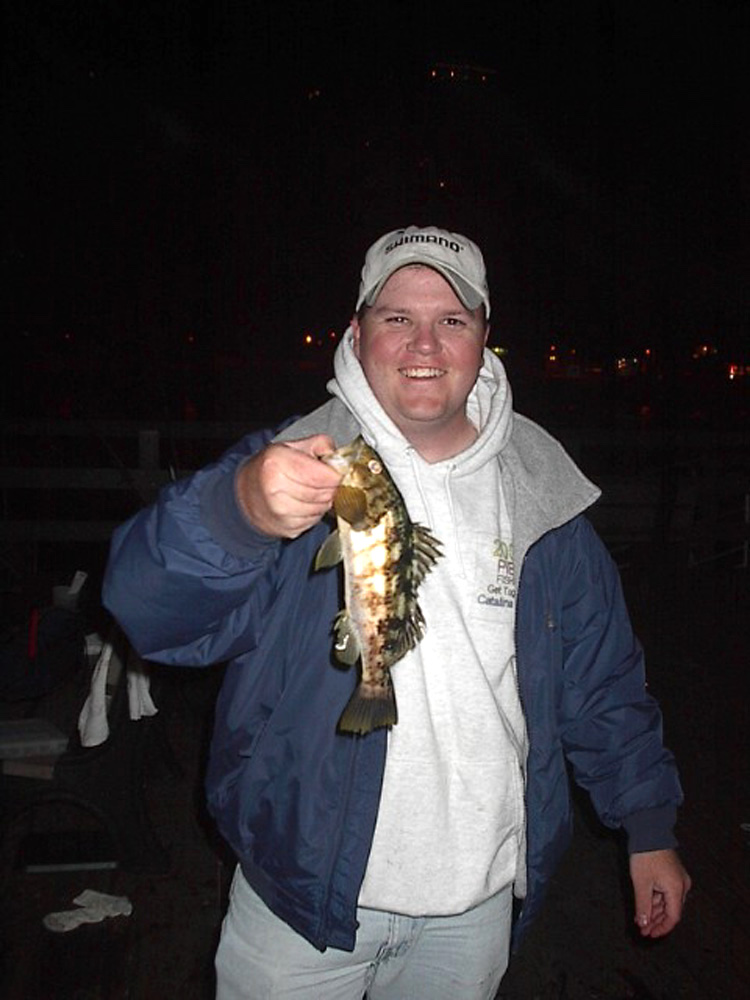
Baitfish (Adam) with a small kelp bass
Halfmoon, opaleye, rock wrasse, blacksmith, and sheephead are available on the bottom or in the mid-water level; on top are jacksmelt and jack mackerel. Pacific mackerel, Pacific sardines and Pacific bonito also are found near the top but are not resident species and are only available some years.
Infrequently an angler will also spot a white seabass or a yellowtail cruising through the water but they’re rarely caught off the pier, they’re more commonly taken from the deeper water of the nearby Mole. Although not as good a spot as the Mole, a few California moray (eels) may also show up.
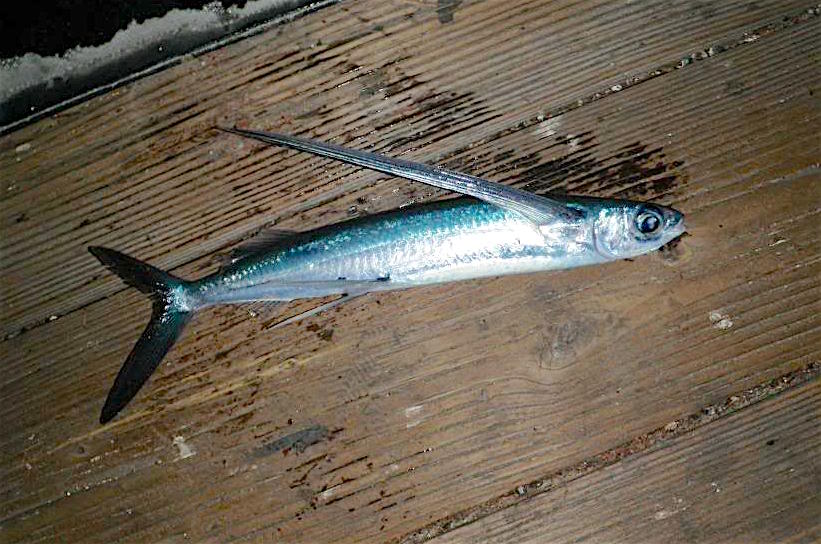
Sometimes at night a flying fish will land on the pier
The pier isn’t a great pier for sharays—sharks and rays, but they do show up. Most common are the somewhat strange looking horn sharks with their pig-like snouts and the equally strange swell sharks that can inflate their bodies with air and water until nearly triple in size. Neither is much of a sporting catch but the big ol’ freight train immitatin’ bat rays, aka mud marlins, are another story; a decent-sized battie will give you a fight to remember. Fishing at night yields most of the sharays but few people make the effort to catch the fish.
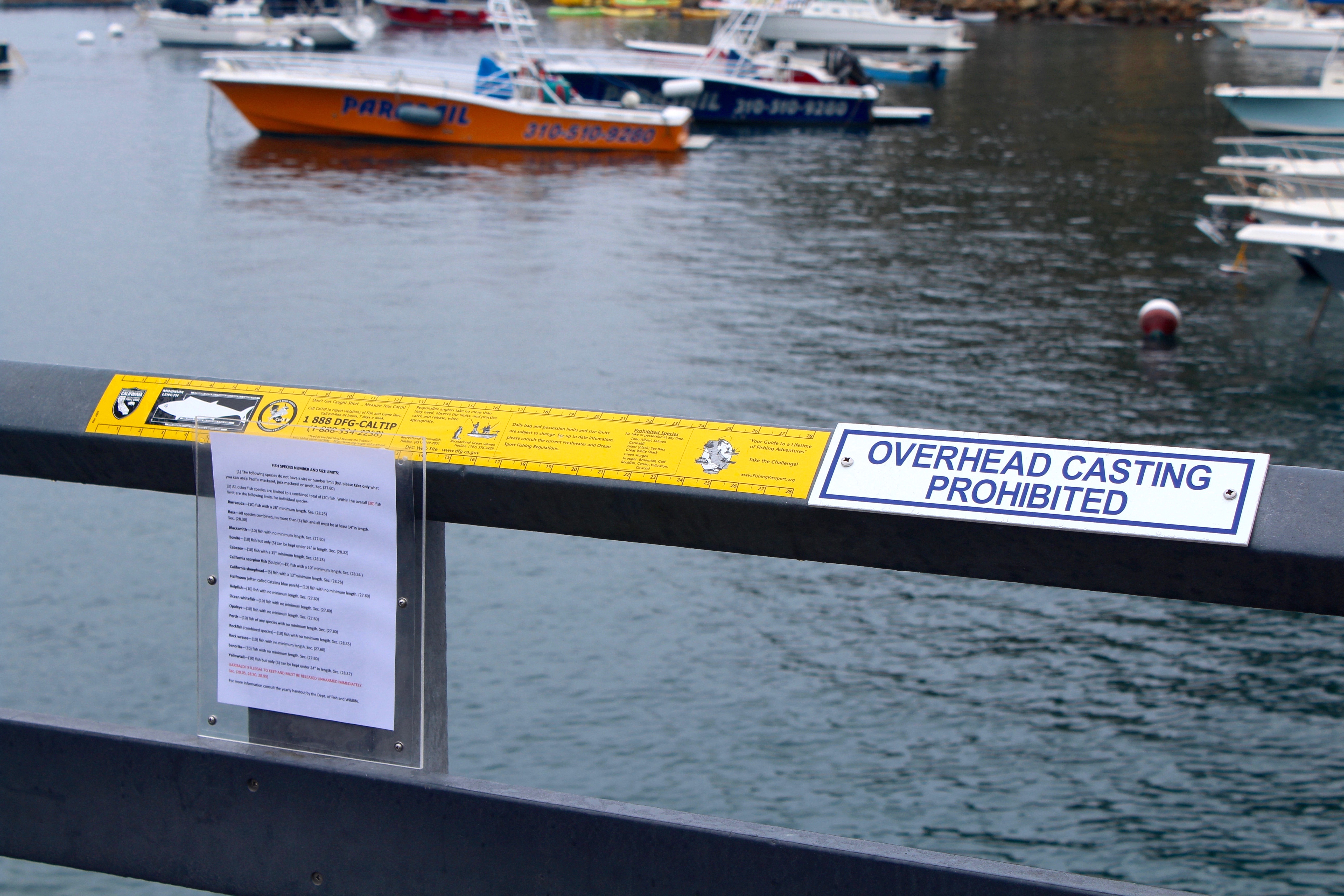
PFIC member Mahigeer (Hashem Nahid) has provided fish regulations (under plexiglass) to help visitors understand the rules.
Fishing Tips — Pretty much anywhere around the end section of pier can yield good fishing but the secret here is to (1) find an open section free of lines and cable and (2) use bait that will get you the species you are after.
If you’re content with the kelp bass, and they are by far the main fish caught at the pier, almost any bait will work. Pieces of fish work best—anchovy and mackerel, but anchovies, in particular, will quickly be shredded by the smaller fish unless a bass gets it first. Hooks, sizes 8-2, should yield an unending number of small bass while larger hooks (up to 2/0) may keep the various perch and perch-imitating species off your hooks and work for larger bass. Some big bass do hang under the pier but the problem is the ropes and other obstructions. You need to strike quickly and get them out into open water as quickly as possible. Remember their 14-inch minimum size requirement.
Two sea chubs, family Kyphosidae, are found at the pier. The first is opaleye and they are the favorite fish for many anglers.
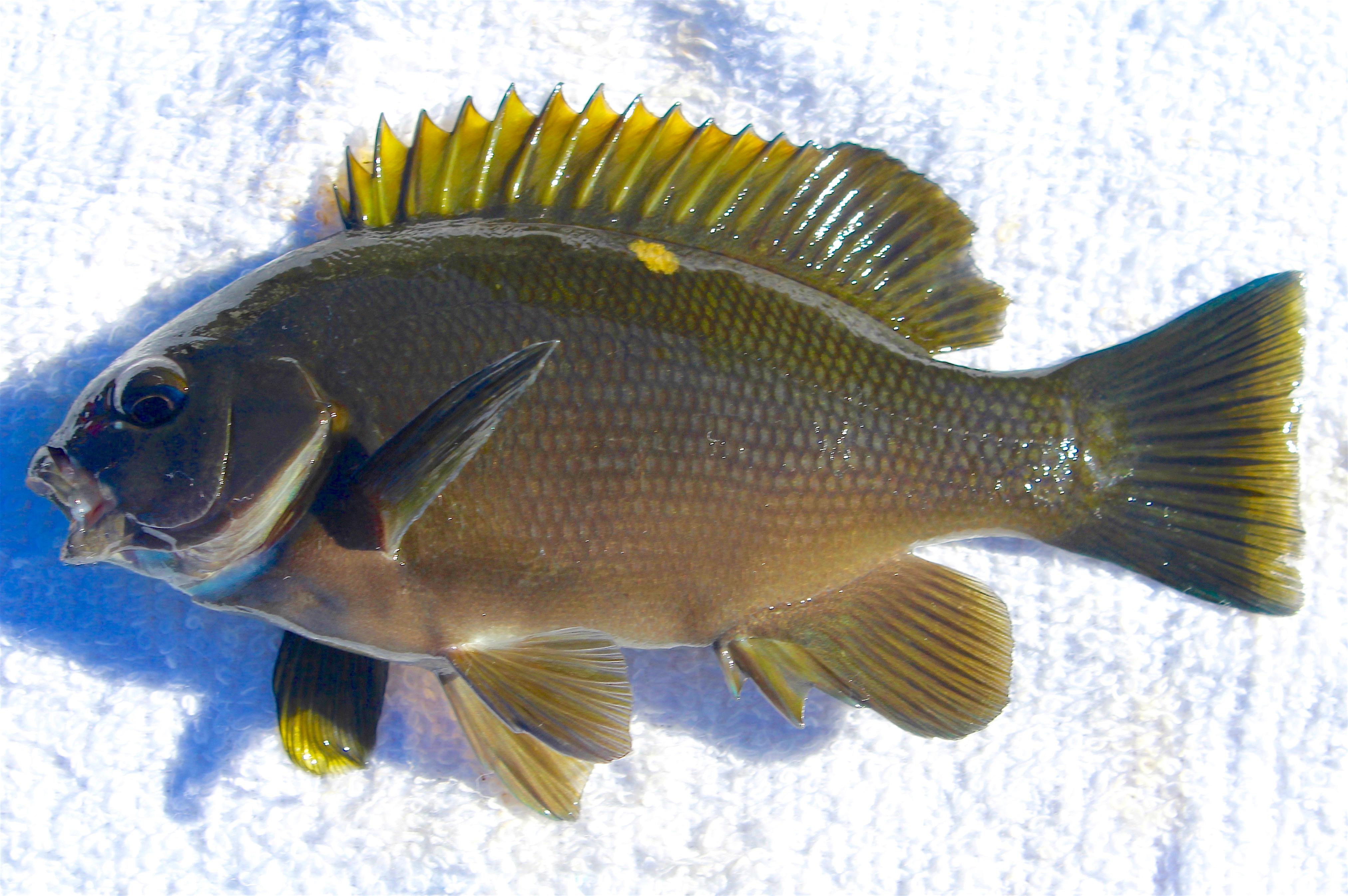
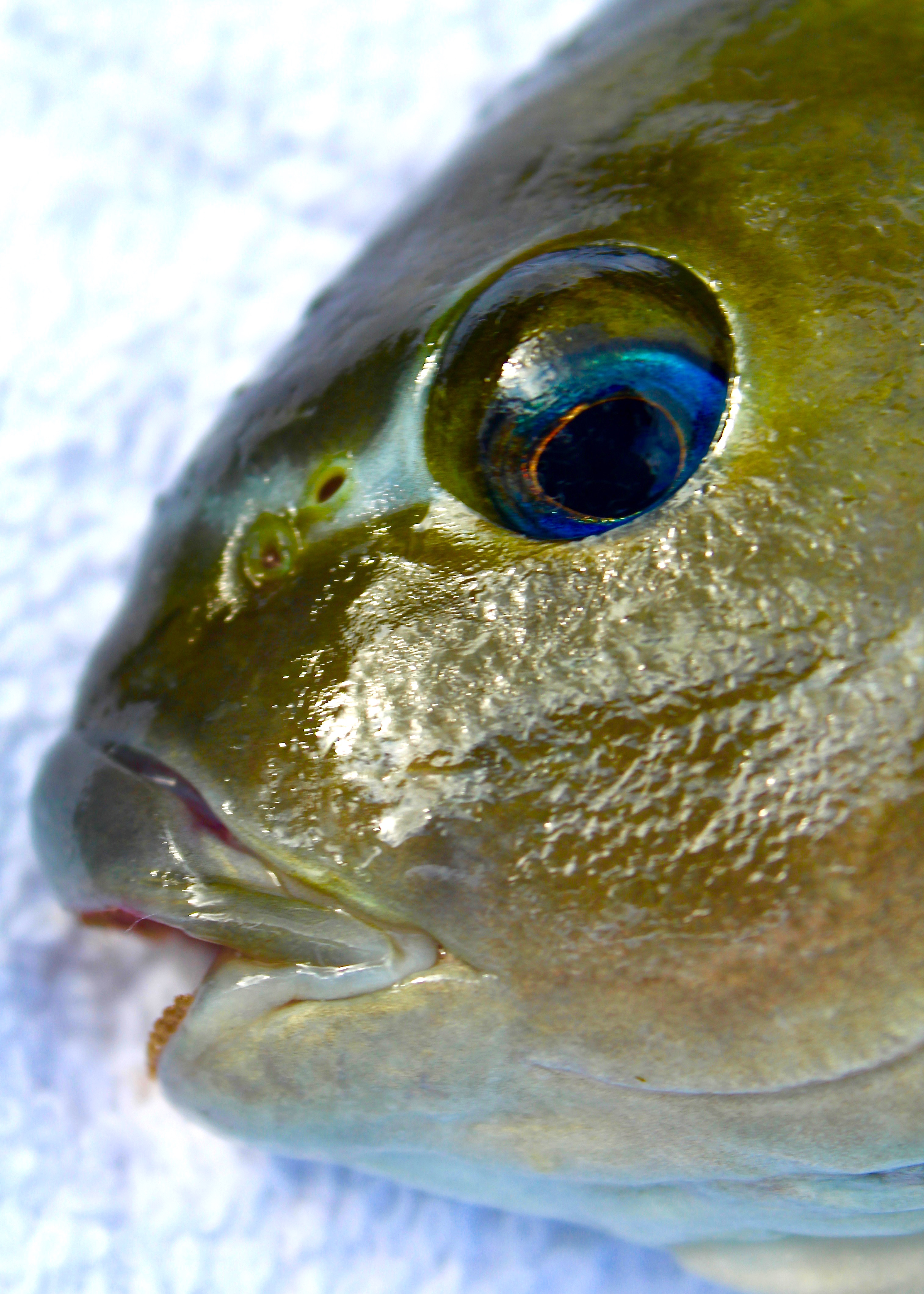
Opaleye
Here you will often see really big schools of really big opaleye. They’ll swim out from underneath the landing dock, spend a few minutes at the front of the pier, and then swim back under another dock simply to emerge a few minutes later. Tourists on the pier will ooh and awe and ask what those big fish are.
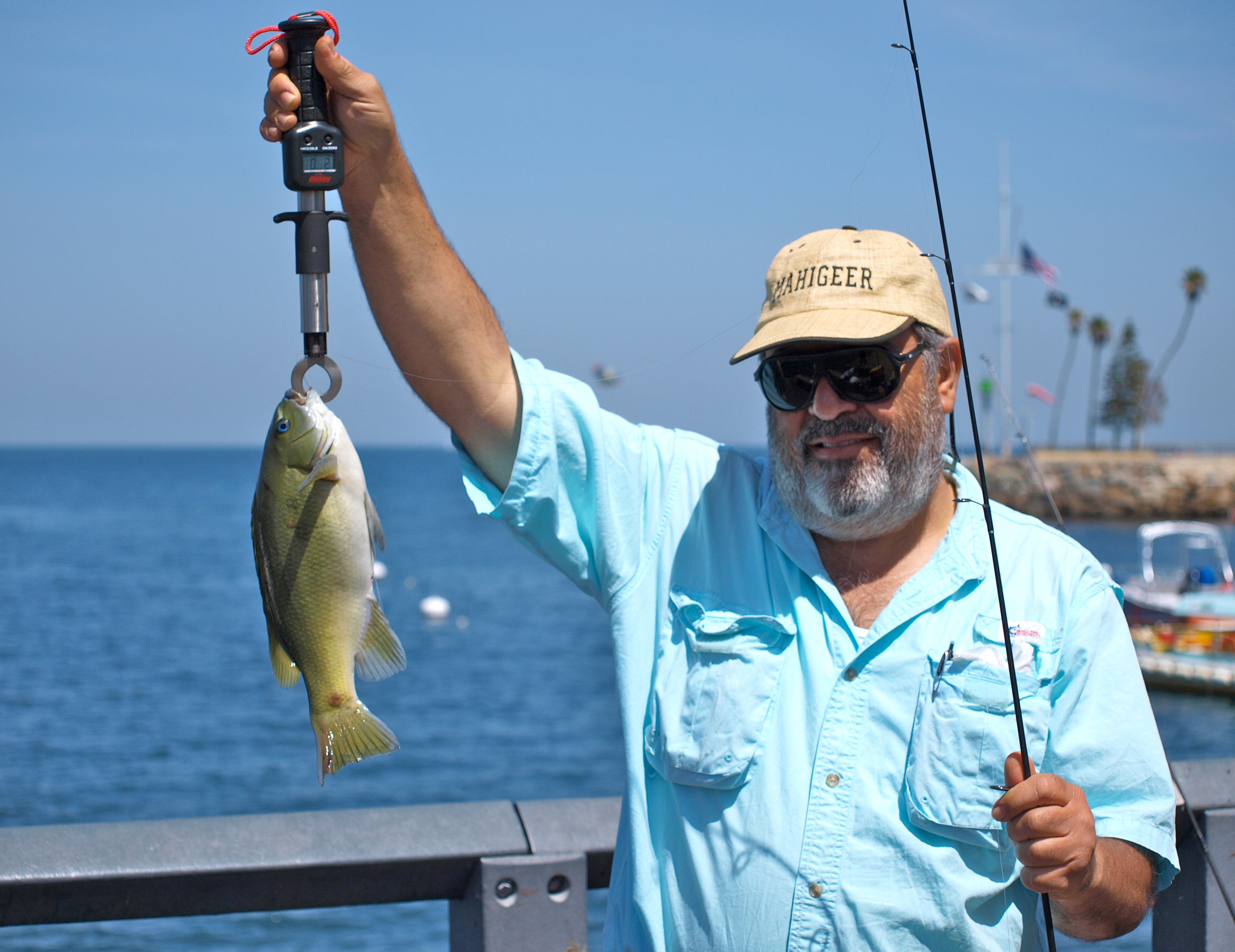
Opaleye caught by Mahigeer (Hashem Nahid)
The opaleye are hard to hook, in fact harder to hook than those out at the Mole. Perhaps it is the crystal-clear water and lack of kelp but they are typically very line shy and hook shy. Most anglers use frozen peas as bait and small hooks (down to size 12-14) fished under a float. Given the water depth you do not need a leader as long as those at the Mole but typically the opaleye will be at mid-water depths. I typically use a high/low rigging and have caught opaleye on frozen peas, fresh mussels, pile worms, bloodworms, ghost shrimp and pieces of market shrimp but true opaleye aficionados typically use peas or green moss. With the exception of the frozen peas and market shrimp that you can buy at local stores, bait will need to be brought from the mainland.
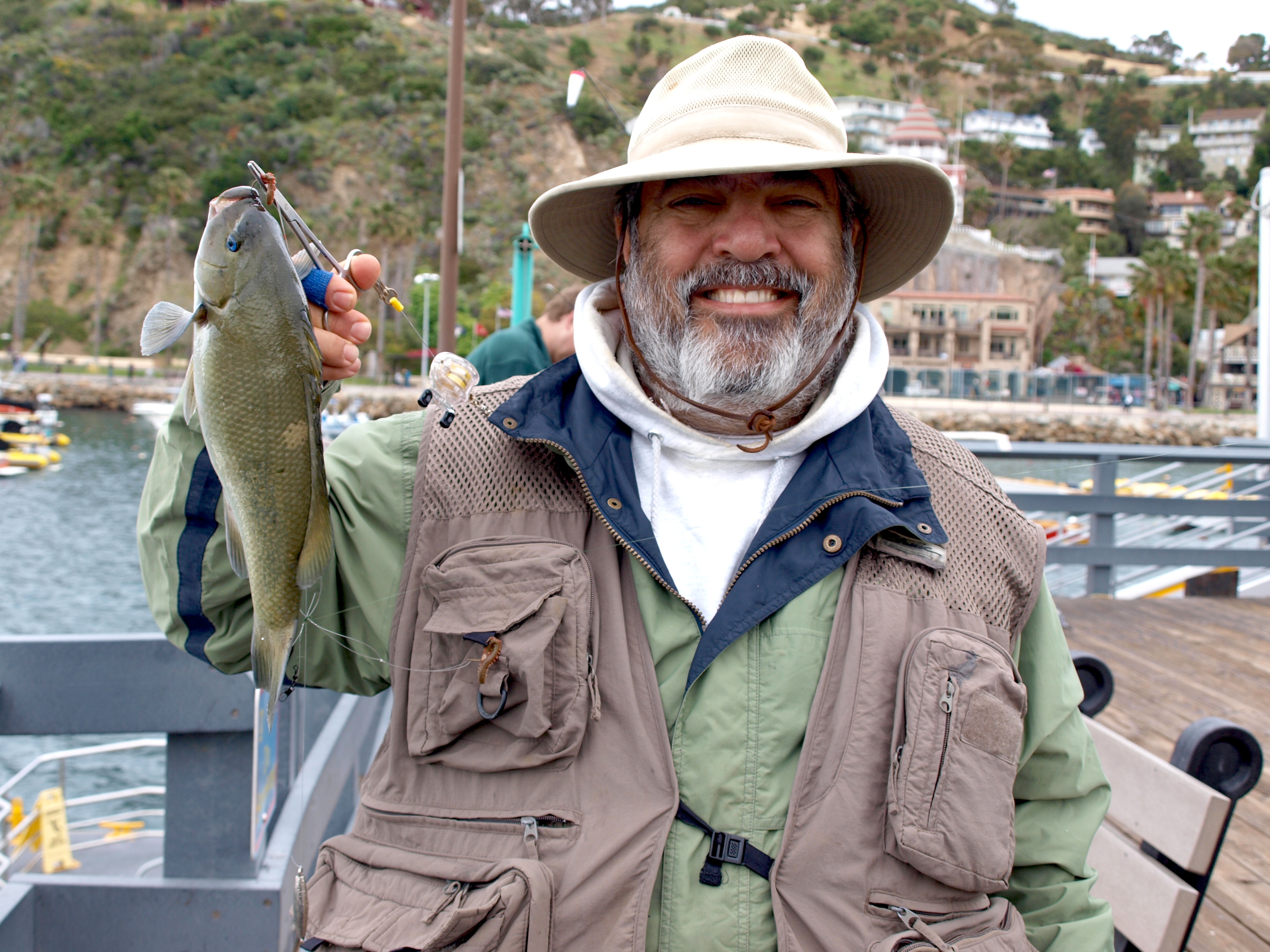
Another opaleye caught by Mahigeer (Hashem Nahid)
The second sea chub is halfmoon, sometimes called the Catalina blue perch. They will be in the same mid-depth regions as the opaleye and can be caught on the same hook under a float approach or a high/low rigging with size 6 hooks. They will take all of the above baits but sometimes will also take small strips of squid. The squid will stay on your hook much better than the other baits but will get far fewer bites; in fact, the fish often just ignore the squid even though the cephalopods are a main bait used by tourists (due to availability).
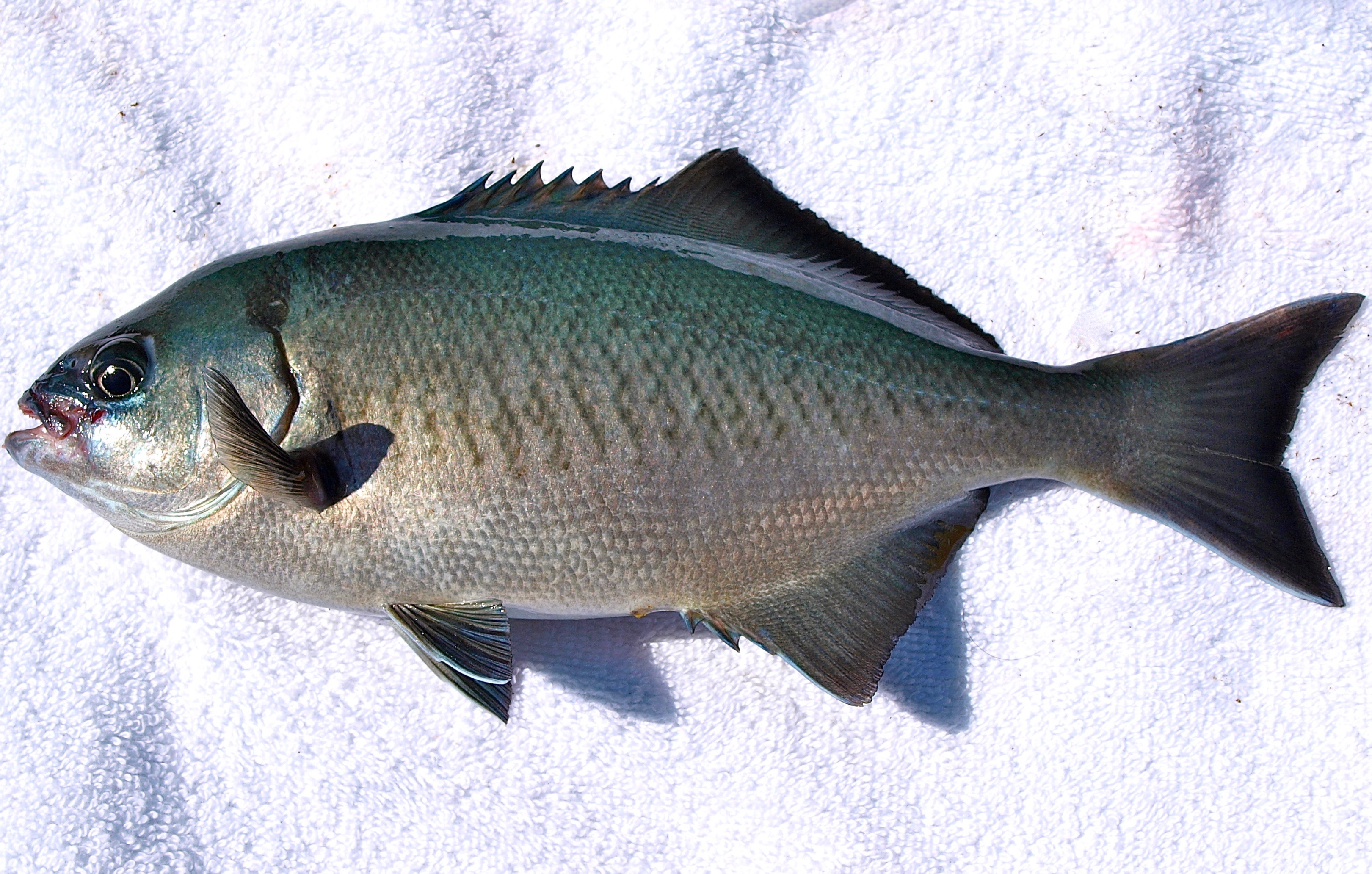
Halfmoon
Two damselfish, family Pomacentridae, are also found at the pier. The first is the beautiful golden and scarlet-hued garibaldi, lovely to watch but illegal to keep. They are almost always found down around the pilings and of course venture out into all the waters around the pier. They almost inevitably join the opaleye, halfmoon, and blacksmith in investigating baits found at mid-water depth, and almost inevitably will also grab bait and be hooked. There isn’t much you can do but make sure you handle them gently and return them as gently to the water as possible.
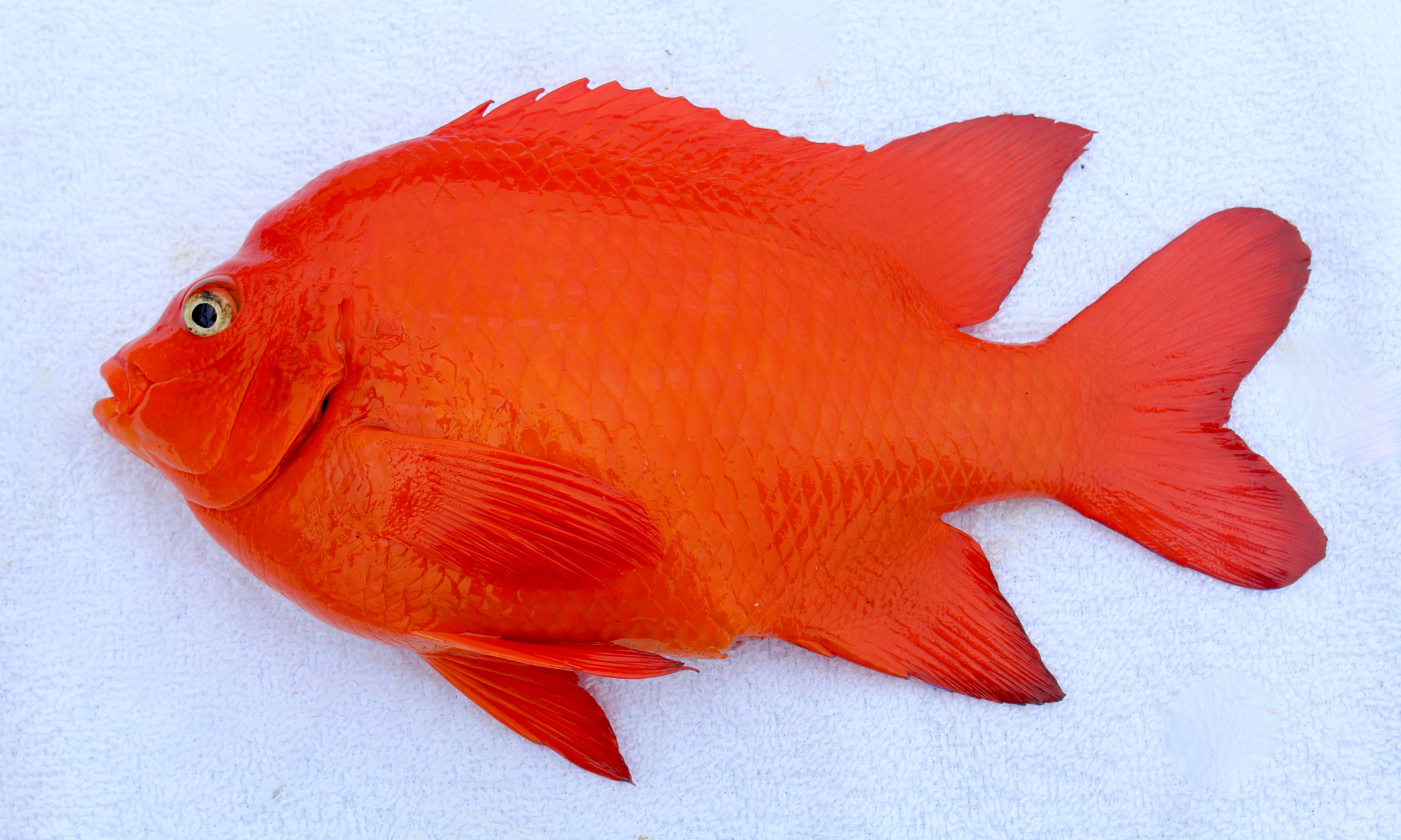
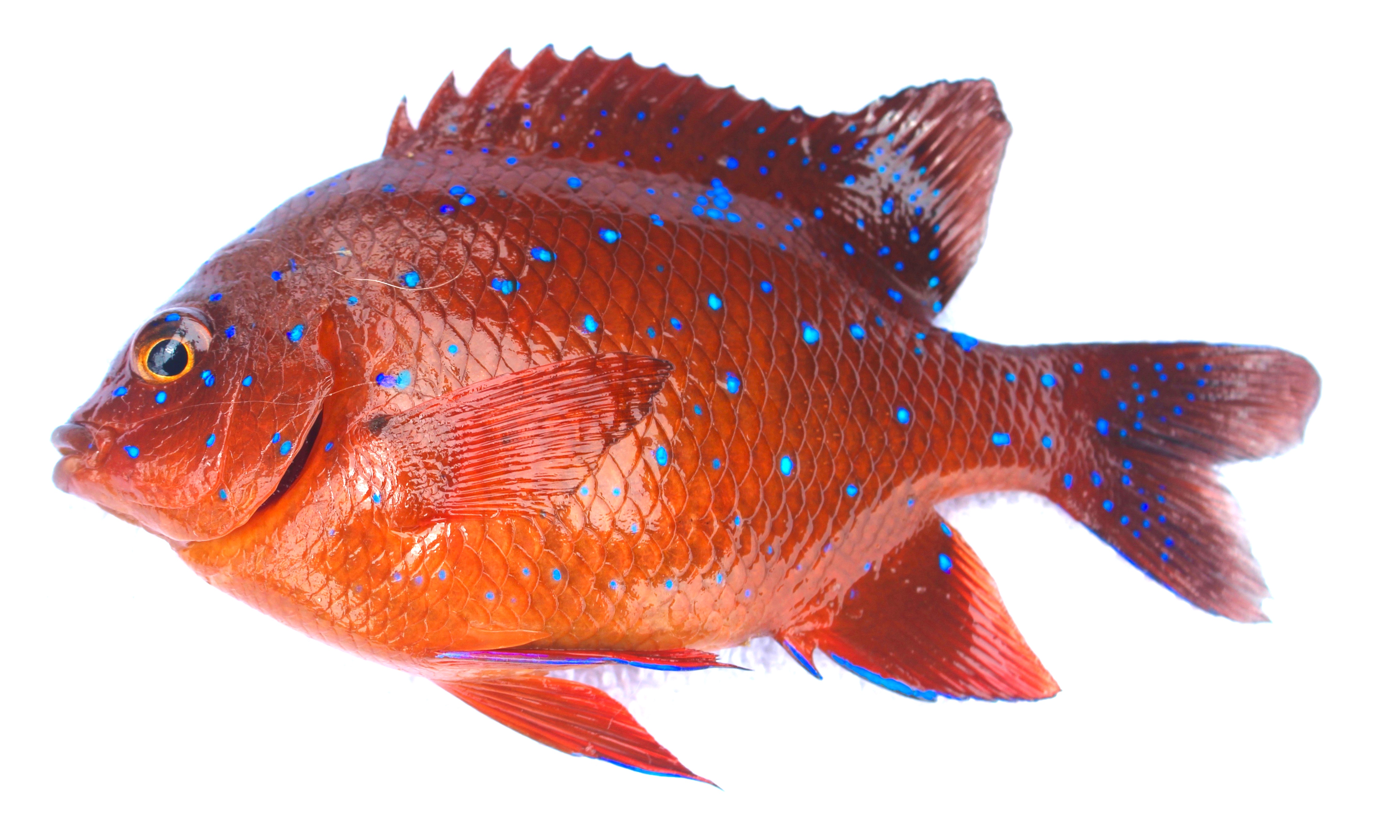
Adult garibaldi (top) and a young garibaldi showing its blue spots (bottom)
The second damselfish is the blacksmith, one more fish found in the mid-depth region that will often swarm the hooks along with the halfmoon, opaleye, bass and senorita. Like the halfmoon, can be caught on any of the above baits and the same tackle. They are typically smaller in size but another pretty little fish.
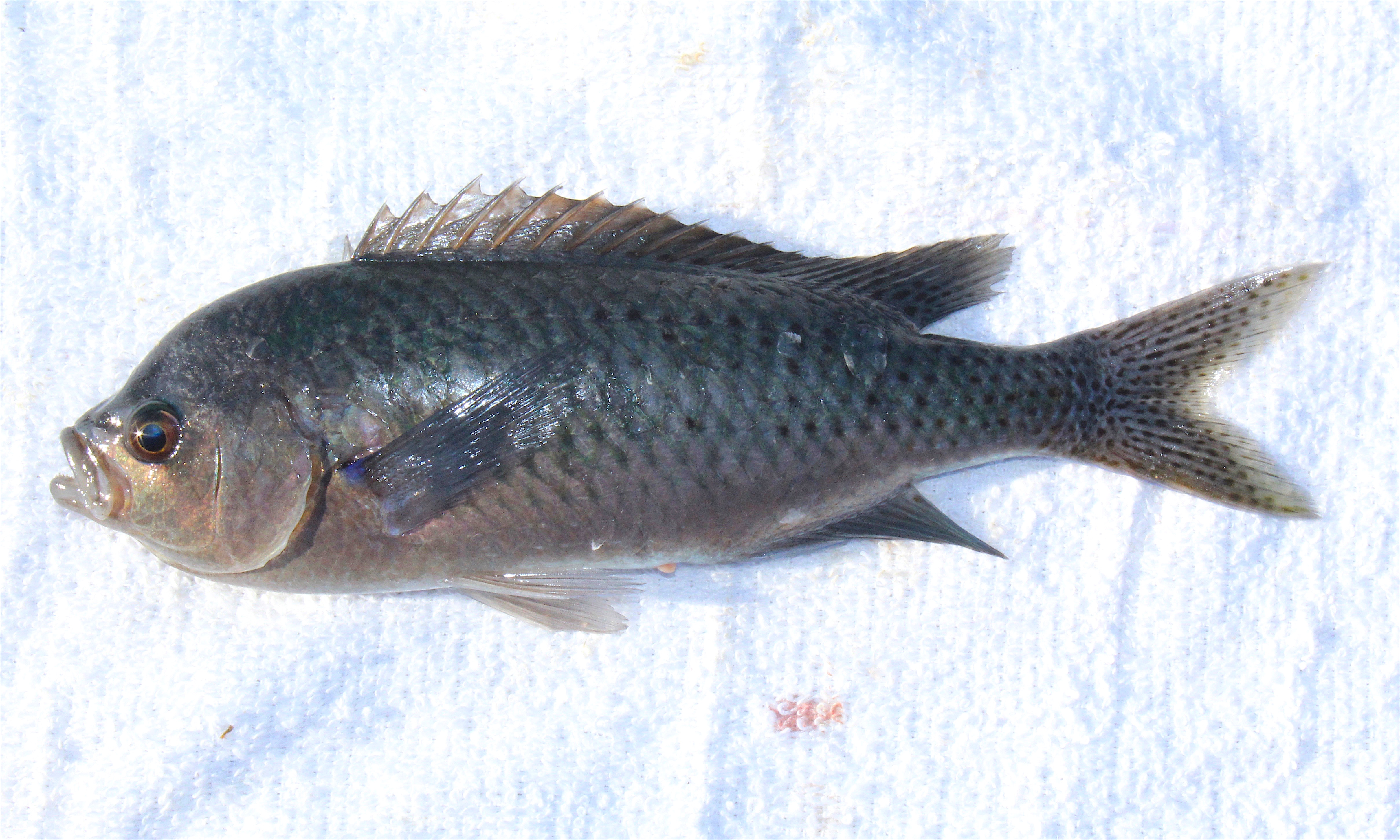
Blacksmith
The wrasses, family Labridae, are well represented at the pier with three family members. All are interesting fish for a number of reasons: (1) their coloring; (2) the fact they sleep at night; and (3) the fact that two of them, the sheephead and rock wrasse, are also protogynous hermaphrodites, big words that simply means they change their sex as they age, beginning as females and becoming males; the verdict is still out on the señorita.
Rock wrasse are one of my favorite light tackle fish at the pier and the small fish (up to about a half-pound in size) put up a surprisingly rugged little fight. They have small mouths and like to rest on the bottom. I’ve found that casting out a high/low leader with two size 8 or 6 hooks above a small torpedo sinker can be deadly. Bait the hooks with pieces of worm and start a retrieve as soon as the rig hits the bottom. Reel in slowly and the wrasse will follow the rig all the way to the pier. They may strike as the bait is moving along the bottom or hit just as the bait starts to be pulled up; in either case once you develop the feel you’ll be able to know when to strike and pull in the fish. The rock wrasse love lug worms, pile worms, bloodworms and, to a lesser extent, small pieces of market shrimp As mentioned, you will not be able to catch them at night since they will be asleep.
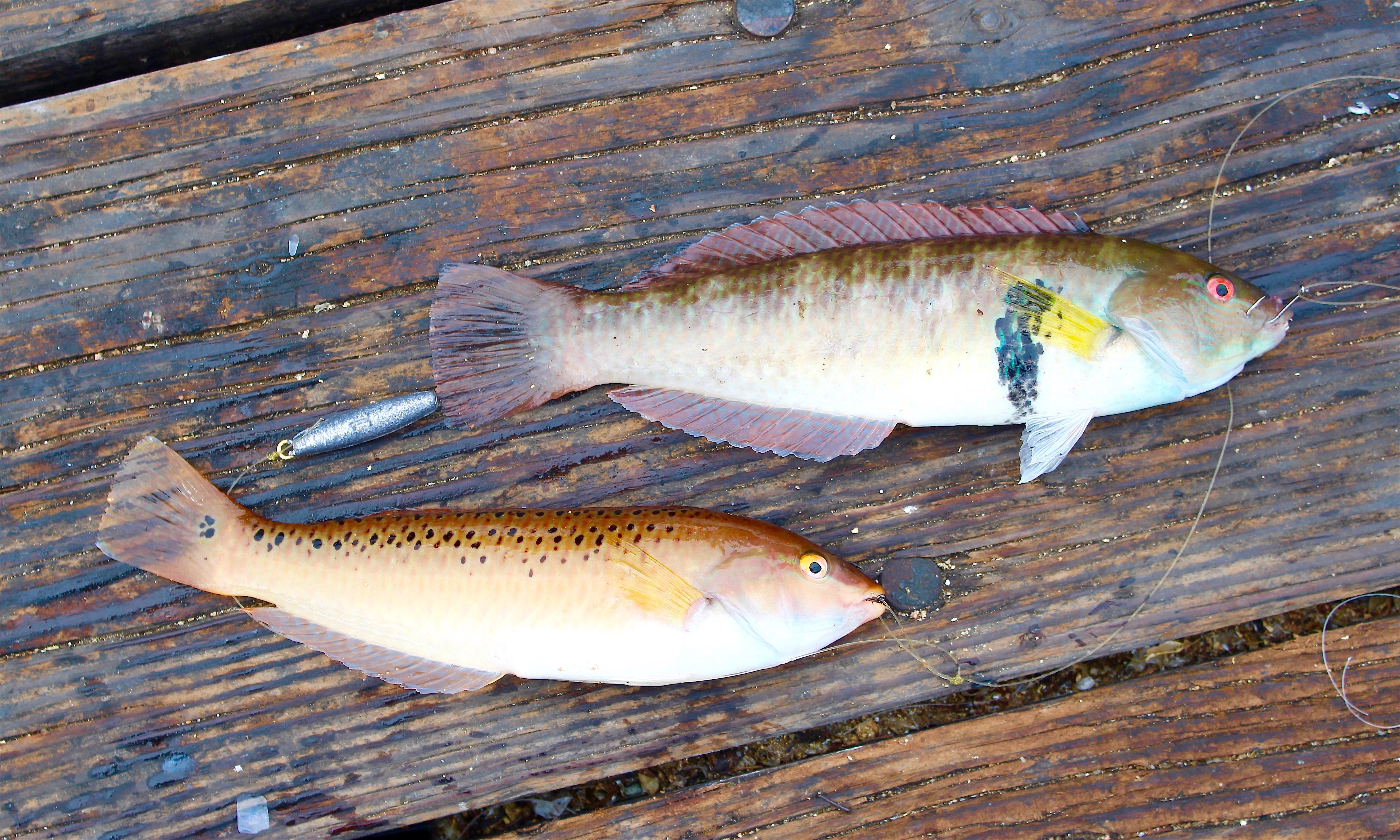
Rock wrasses — male (with stripe) and female
The second wrasse, generally smaller in size, are the dreaded señorita. Dreaded? Señorita are the peskiest bait stealers you’ll encounter and love to strip worms and other soft baits from the small hooks you’re using. But, you need small hooks if you’re seeking these bottom species. The señorita tend to grab the bait in the mid-depth range but they may grab it anywhere from the bottom to the top and it doesn’t seem to matter what you are using for bait, they will find it and attack it.
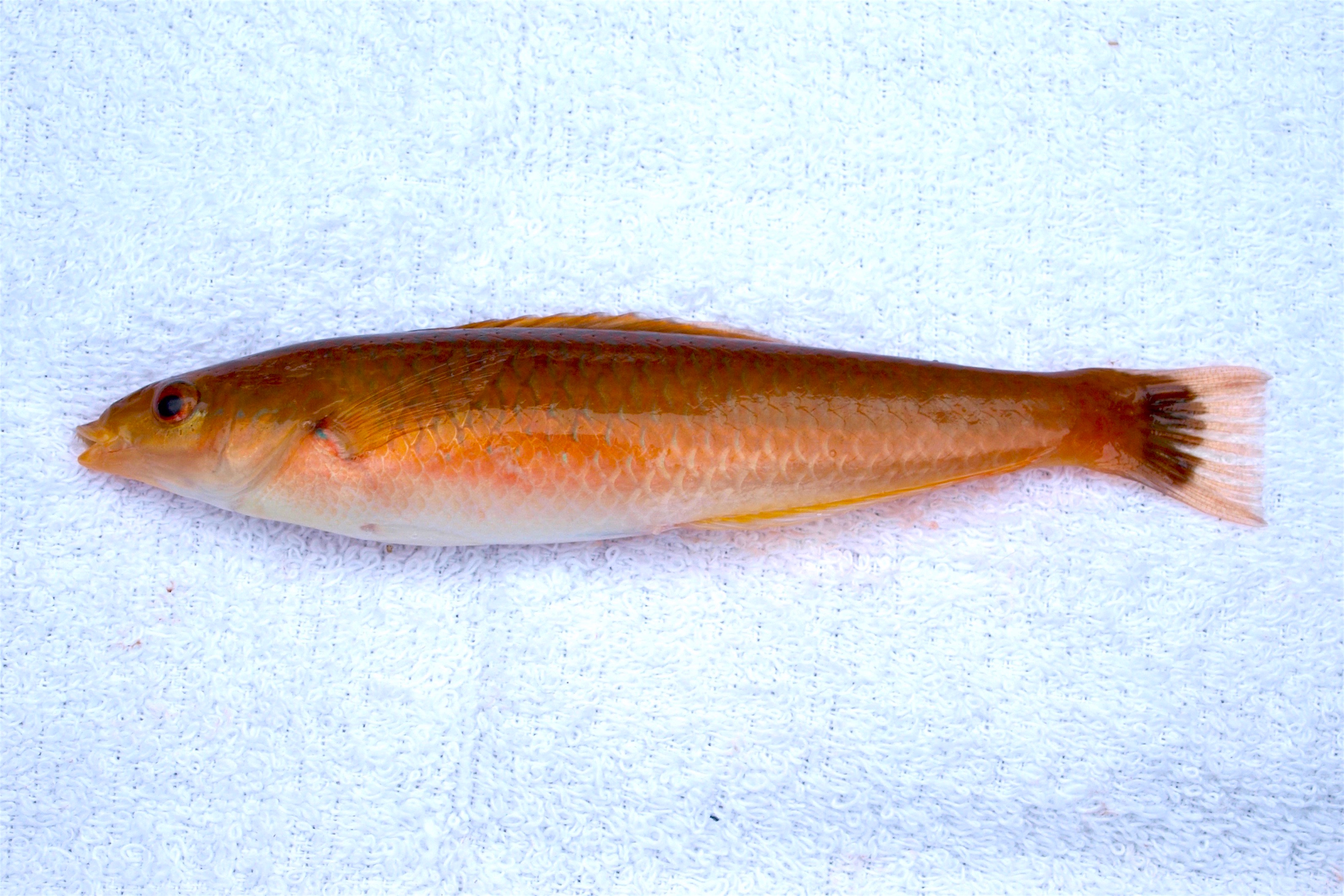
Señorita — sometimes called cigar fish due to their shape
The third wrasse found at the pier, sheephead, is the largest and one of the favorite fish caught by pier anglers.
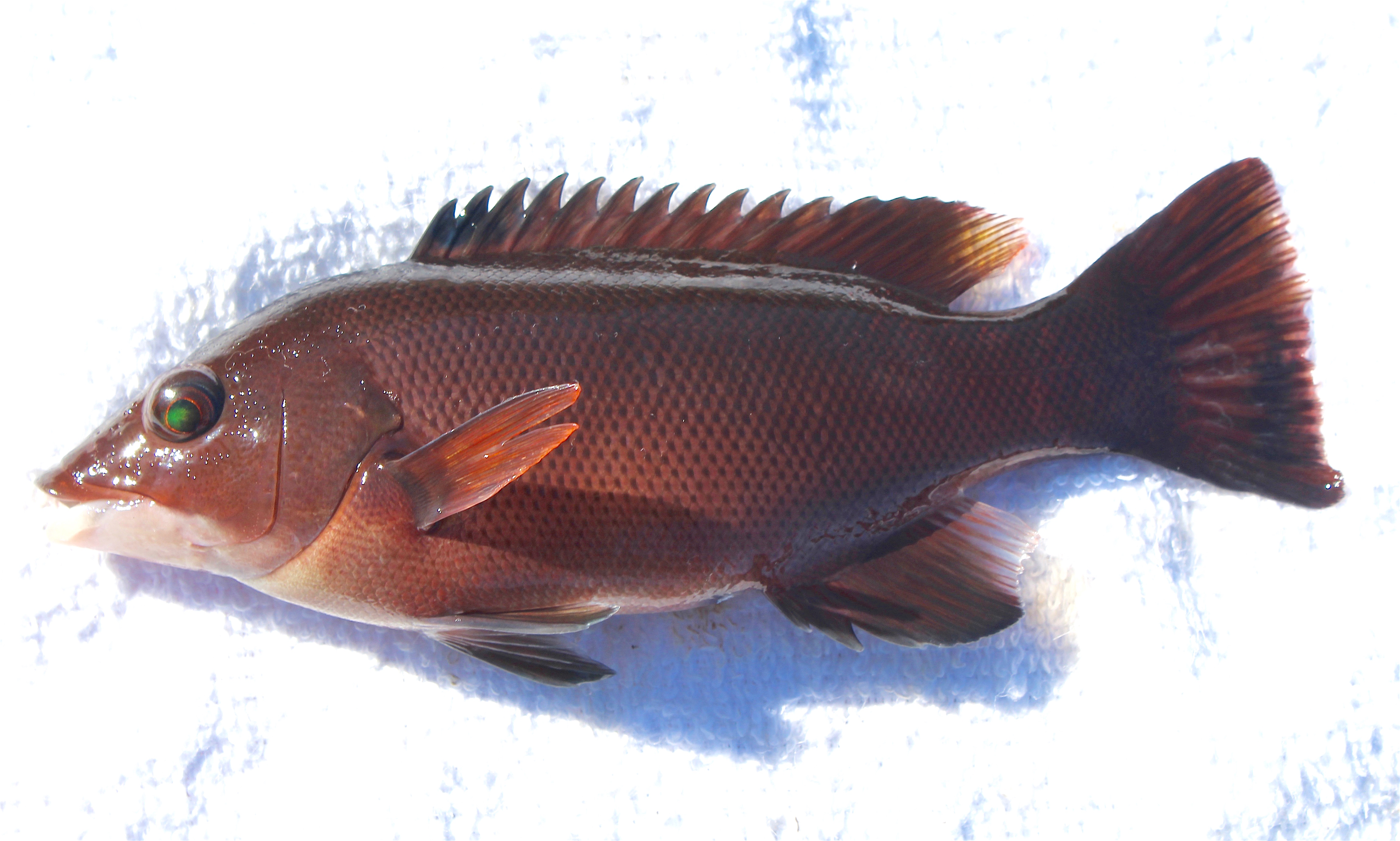
Sheephead
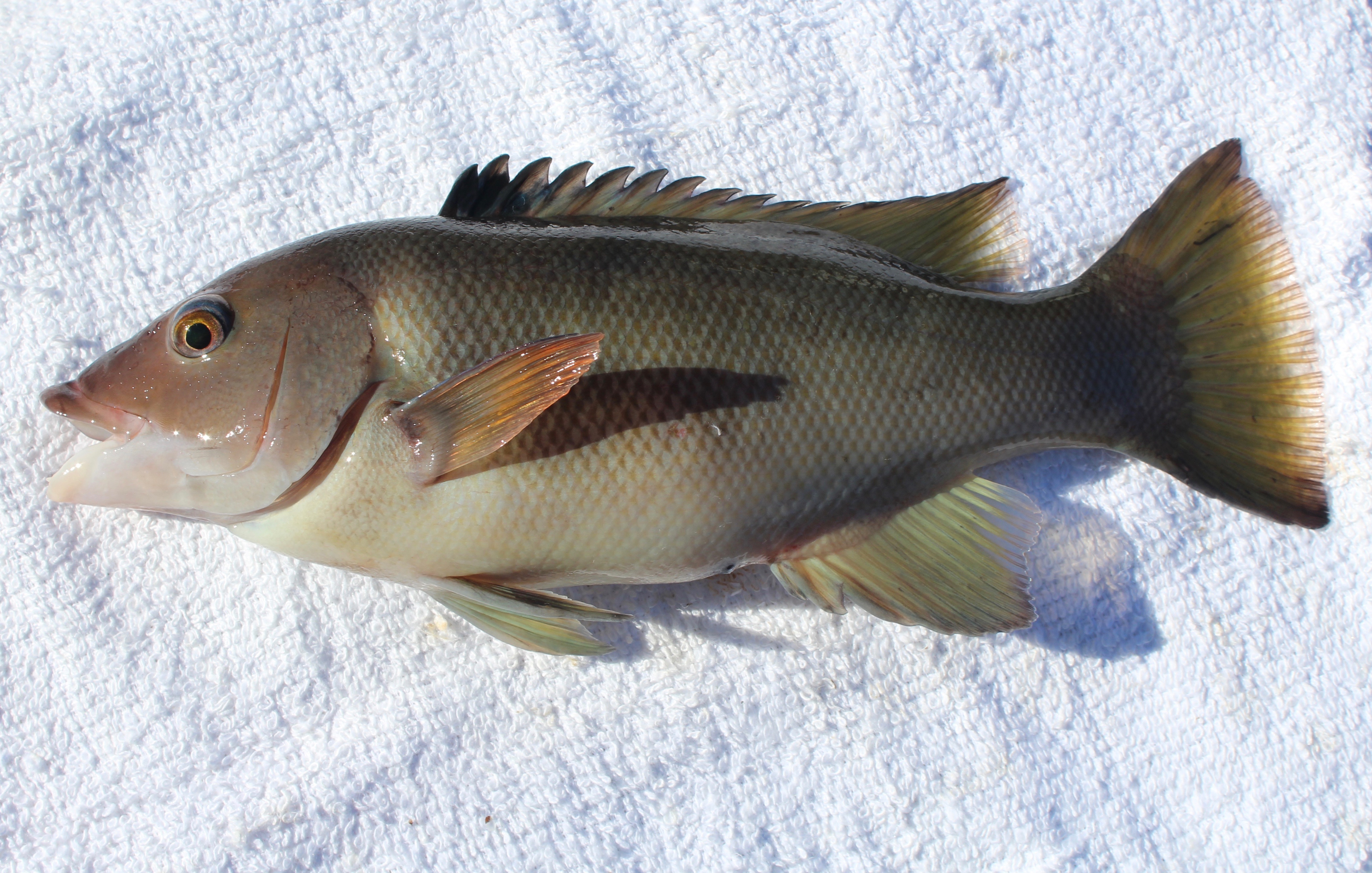
A sheephead about ready to undergo the change from female to male. They change color and they develop a hump on their head as they grow larger.
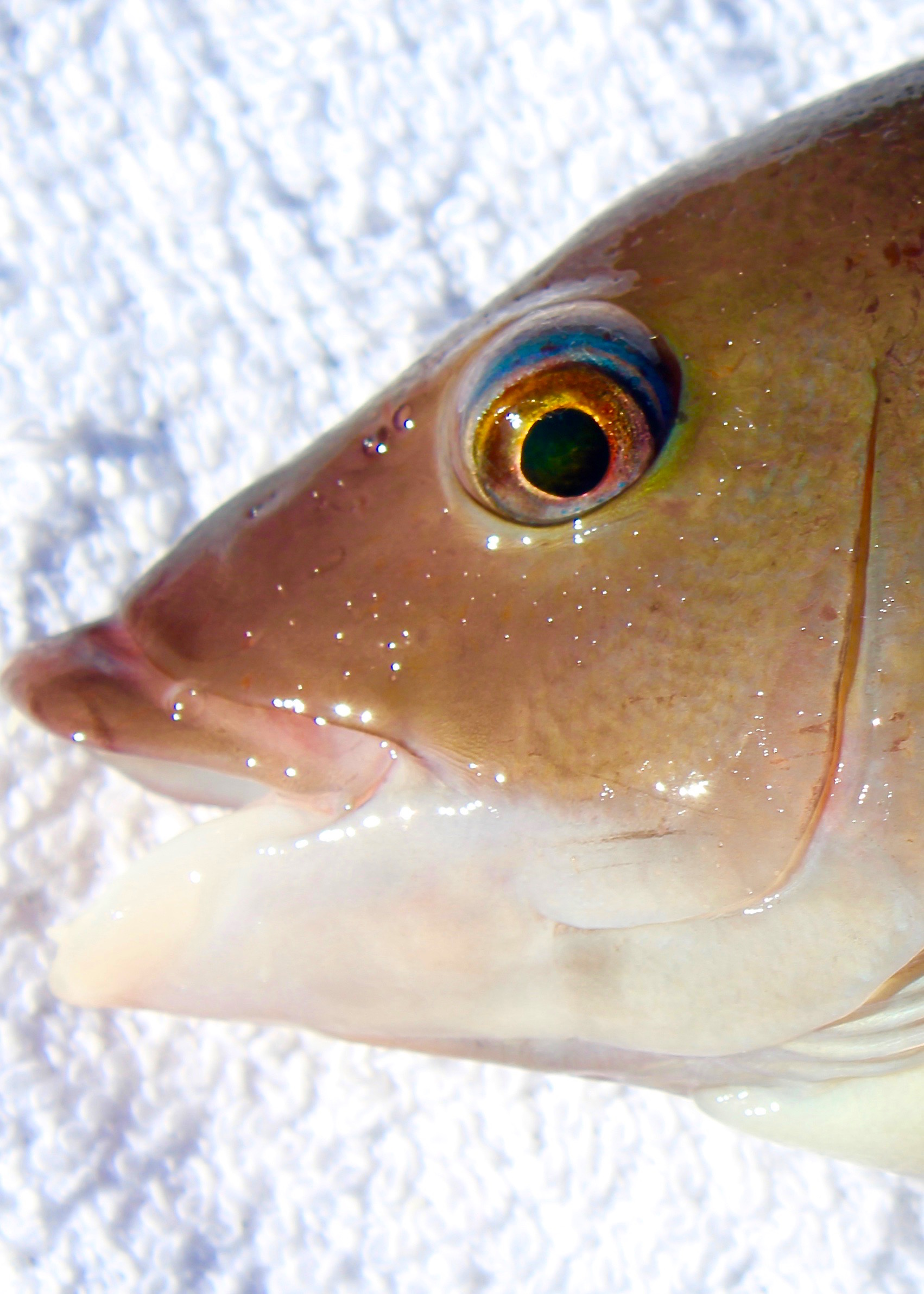
The head of a young sheephead
The sheephead can range from mere youngsters up to fish several pounds in size and I’ve caught as many and as big sheephead at the pier as out at the Mole in deeper water.
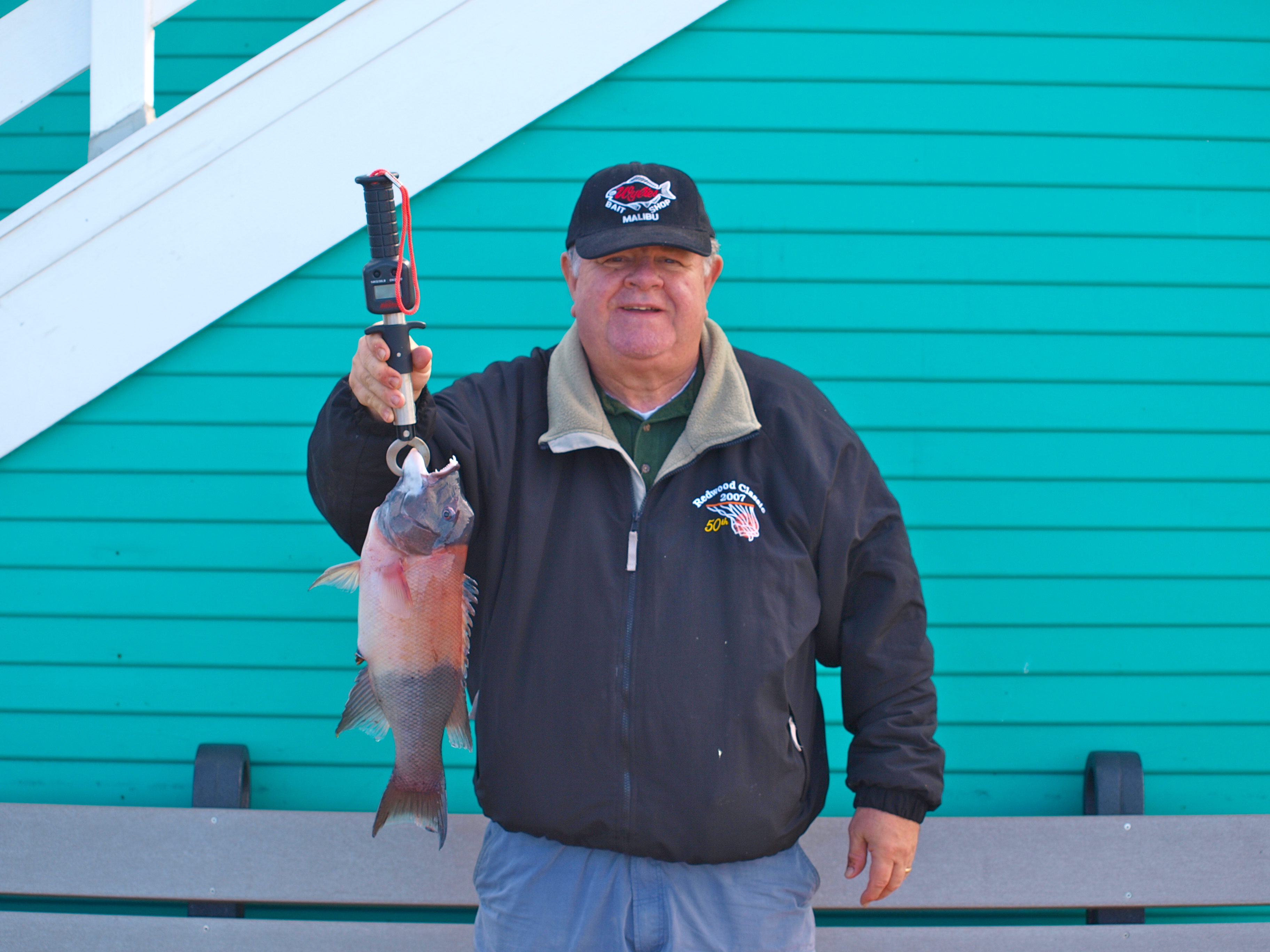
Sheephead caught by Ken Jones
A high/low leader with size 4-2 hooks is the most common rigging and the favorite bait is ghost shrimp followed by market shrimp (although I have caught them on almost every bait listed above). The largest sheephead I caught at the pier followed a fairly long cast out on the left side of the pier but I’ve caught them under the pier, in the waters between the pier and landing float, and under floats on both sides of the pier. They move around. Do remember they must be 12-inches in length to keep. As with the other wrasses, they are not caught at night because they are asleep on the ocean floor.
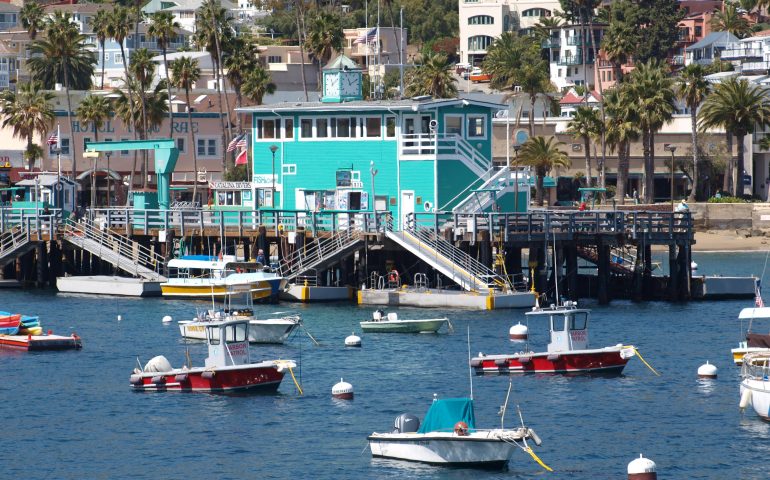
[…] the bike tour we walked around Green Pleasure Pier while we waited for our Jeep tour. We had about an hour to kill so we window shopped. You will not […]